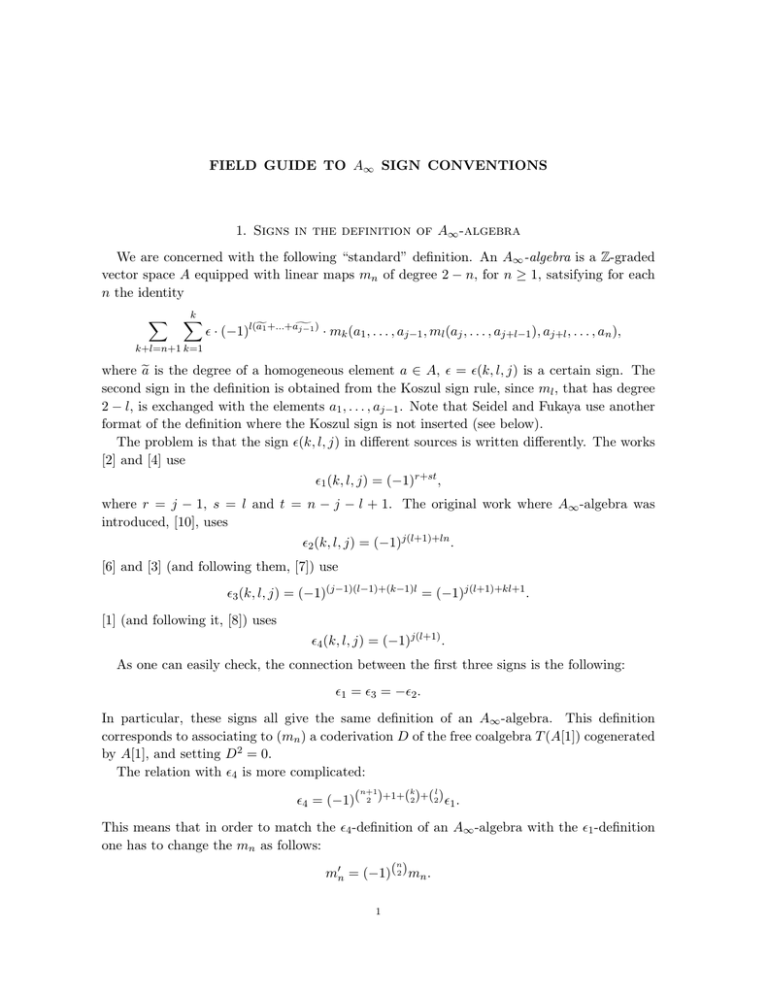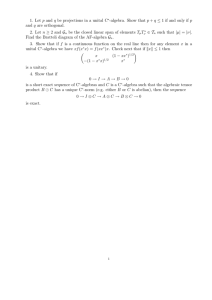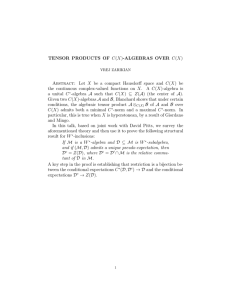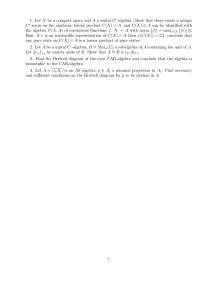Field guide to A-infinity sign conventions
advertisement

FIELD GUIDE TO A∞ SIGN CONVENTIONS 1. Signs in the definition of A∞ -algebra We are concerned with the following “standard” definition. An A∞ -algebra is a Z-graded vector space A equipped with linear maps mn of degree 2 − n, for n ≥ 1, satsifying for each n the identity X k X a1 +...+ag j−1 ) · (−1)l(f · mk (a1 , . . . , aj−1 , ml (aj , . . . , aj+l−1 ), aj+l , . . . , an ), k+l=n+1 k=1 where e a is the degree of a homogeneous element a ∈ A, = (k, l, j) is a certain sign. The second sign in the definition is obtained from the Koszul sign rule, since ml , that has degree 2 − l, is exchanged with the elements a1 , . . . , aj−1 . Note that Seidel and Fukaya use another format of the definition where the Koszul sign is not inserted (see below). The problem is that the sign (k, l, j) in different sources is written differently. The works [2] and [4] use 1 (k, l, j) = (−1)r+st , where r = j − 1, s = l and t = n − j − l + 1. The original work where A∞ -algebra was introduced, [10], uses 2 (k, l, j) = (−1)j(l+1)+ln . [6] and [3] (and following them, [7]) use 3 (k, l, j) = (−1)(j−1)(l−1)+(k−1)l = (−1)j(l+1)+kl+1 . [1] (and following it, [8]) uses 4 (k, l, j) = (−1)j(l+1) . As one can easily check, the connection between the first three signs is the following: 1 = 3 = −2 . In particular, these signs all give the same definition of an A∞ -algebra. This definition corresponds to associating to (mn ) a coderivation D of the free coalgebra T (A[1]) cogenerated by A[1], and setting D2 = 0. The relation with 4 is more complicated: n+1 k l 4 = (−1)( 2 )+1+(2)+(2) 1 . This means that in order to match the 4 -definition of an A∞ -algebra with the 1 -definition one has to change the mn as follows: n m0n = (−1)( 2 ) mn . 1 Seidel uses very different sign conventions. In [9] the A∞ -identity looks as follows: X k X j−1 +j−1 (−1)af1 +...+ag · mk (a1 , . . . , aj−1 , ml (aj , . . . , aj+l−1 ), aj+l , . . . , an ), k+l=n+1 k=1 which for example does not correspond to the usual associativity if there is only m2 . To connect this to the definition corresponding to 1 one has to make the following change of sign: a1 +(n−2)f a2 +...+^ an−1 m0n (a1 , . . . , an ) = (−1)(n−1)f mn (a1 , . . . , an ). 2. Sign in the definition of the Gerstenhaber bracket Interpreting a Hochschild cochain f ∈ Hom(A⊗n , A) as giving rise to a coderivation Df of the free coalgebra T (A[1]), we obtain the definition of Gerstenhaber bracket [f, g] of Hochschild cochains, so that D[f,g] = [Df , Dg ], where on the right we have a supercommutator. This leads to the following formula for f ∈ Hom(A⊗m , A), g ∈ Hom(A⊗n , A) [f, g] = f ¯◦g − (−1)|f ||g| g¯ ◦f, where f ¯◦g(a1 , . . . , am+n−1 ) = m X a1 +...+ag i−1 +m−1) deg(g)+(i−1)(n−1) (−1)(f f (a1 , . . . , ai−1 , g(ai , . . . , ai+n−1 ), ai+n , . . . , am+n−1 ), i=1 where for a cochain f ∈ Hom(A⊗m , A), homogeneous of degree deg(f ), we set |f | = deg(f ) + m − 1. Note that in the case when A sits in degree 0 this is compatible with the usual definition, say, in [5, E.1.5.2]. Bibliography [1] E. Getlzer, J. D. S. Jones, A∞ -algebras and the cyclic bar complex, Illinois J. Math. 34 (1990), no. 2, 256–283. [2] B. Keller, Introduction to A-infinity algebras and modules, Homology Homotopy Appl. 3 (2001), no. 1, 1–35. [3] M. Kontsevich, Y. Soibelman, Homological mirror symmetry and torus fibration, in Symplectic geometry and mirror symmetry (Seoul, 2000), 203–263, World Sci. Publishing, River Edge, NJ, 2001. [4] K. Lefèvre-Hasegawa, Sur les A∞ -catégories, Thèse de doctorat, Université Denis Diderot – Paris 7, 2003, available at B. Keller’s homepage. [5] J.-L. Loday, Cyclic homology, Springer-Verlag. 1992. [6] S. Merkulov, Strong homotopy algebras of a Kähler manifold, Internat. Math. Res. Notices 1999, no.3, 153–164. [7] A. Polishchuk, Homological mirror symmetry with higher products, in Proceedings of the Winter School on Mirror Symmetry, Vector Bundles and Lagrangian Submanifolds, 247–259, AMS and International Press, 2001. [8] A, Polishchuk, A∞ -structures on an elliptic curve, Comm. Math. Phys. 247 (2004), 527–551. [9] P. Seidel, Fukaya categories and Picard-Lefschetz theory, EMS, Zurich, 2008. [10] J. D. Stasheff, Homotopy associativity of H-spaces II, Trans. AMS 108 (1963), 293–312. 2




